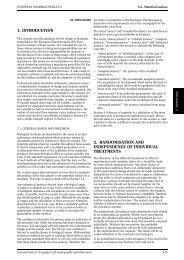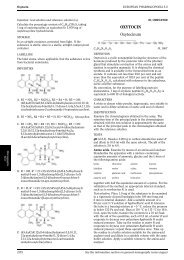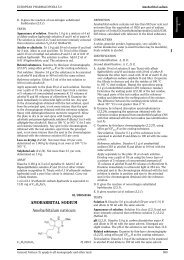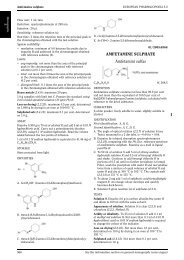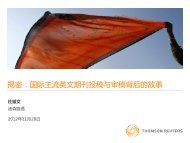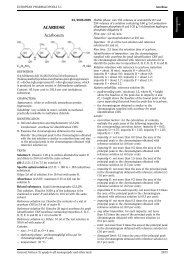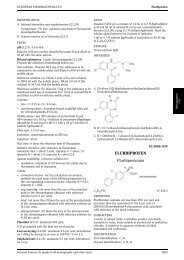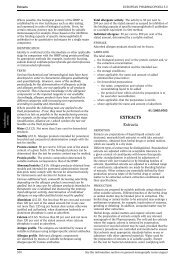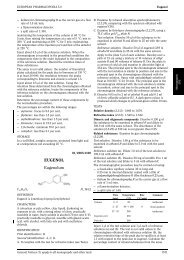TRAGACANTH Tragacantha
TRAGACANTH Tragacantha
TRAGACANTH Tragacantha
You also want an ePaper? Increase the reach of your titles
YUMPU automatically turns print PDFs into web optimized ePapers that Google loves.
Tragacanth EUROPEAN PHARMACOPOEIA 5.0<br />
STORAGE<br />
Store in an airtight container, protected from light, at a<br />
temperature of 8 °C to 15 °C.<br />
<strong>TRAGACANTH</strong><br />
<strong>Tragacantha</strong><br />
01/2005:0532<br />
DEFINITION<br />
Tragacanth is the air-hardened, gummy exudate, flowing<br />
naturallyorobtainedbyincisionfromthetrunkand<br />
branches of Astragalus gummifer Labill. and certain other<br />
species of Astragalus from western Asia.<br />
CHARACTERS<br />
It has the macroscopic and microscopic characters described<br />
under identification test A and B.<br />
IDENTIFICATION<br />
A. Tragacanth occurs in thin, flattened, ribbon-like, white<br />
or pale yellow, translucent strips, about 30 mm long<br />
and 10 mm wide and up to 1 mm thick, more or less<br />
curved;horny,fractureshort;thesurfaceismarkedby<br />
fine longitudinal striae and concentric transverse ridges.<br />
It may also contain pieces similar in shape but somewhat<br />
thicker, more opaque and more difficult to fracture.<br />
B. Reduce to a powder (355). The powder is white or almost<br />
white and it forms a mucilaginous gel with about ten times<br />
itsmassofwater R. Examine under a microscope using<br />
a50percentV/V solution of glycerol R. Thepowder<br />
shows in the gummy mass numerous stratified cellular<br />
membranes turning slowly violet when treated with<br />
iodinated zinc chloride solution R. Thegummymass<br />
includes starch grains, isolated or in small groups,<br />
usually rounded in shape and sometimes deformed, with<br />
diameters varying between 4 µm and 10 µm, occasionally<br />
up to 20 µm, and a central hilum visible between crossed<br />
nicol prisms.<br />
C. Examine the chromatograms obtained in the test for<br />
acacia. The chromatogram obtained with the test solution<br />
shows three zones, corresponding to galactose, arabinose<br />
and xylose. A faint yellowish zone at the solvent front and<br />
a greyish-green zone between the zones due to galactose<br />
and arabinose may be present.<br />
D. Moisten 0.5 g of the powdered drug (355) with 1 ml<br />
of alcohol R and add gradually, while shaking, 50 ml<br />
of water R until a homogeneous mucilage is obtained.<br />
To 5 ml of the mucilage add 5 ml of water R and 2 ml<br />
of barium hydroxide solution R. Aslightflocculent<br />
precipitate is formed. Heat on a water-bath for 10 min. An<br />
intense yellow colour develops.<br />
TESTS<br />
Acacia. Examine by thin-layer chromatography (2.2.27),<br />
using a TLC silica gel plate R.<br />
Test solution. To 100 mg of the powdered drug (355) in<br />
a thick-walled, centrifuge test tube, add 2 ml of a 100 g/l<br />
solution of trifluoroacetic acid R, shakevigorouslyto<br />
dissolve the forming gel, stopper the test tube and heat<br />
themixtureat120°Cfor1h.Centrifugethehydrolysate,<br />
transfer the clear supernatant carefully into a 50 ml flask,<br />
add 10 ml of water R and evaporate the solution to dryness<br />
under reduced pressure. To the resulting clear film add<br />
0.1 ml of water R and 0.9 ml of methanol R. Centrifuge<br />
to separate the amorphous precipitate and dilute the<br />
supernatant if necessary to 1 ml with methanol R.<br />
Reference solution. Dissolve 10 mg of arabinose R, 10mg<br />
of galactose R, 10mgofrhamnose R and 10 mg of xylose R<br />
in 1 ml of water R and dilute to 10 ml with methanol R.<br />
Apply to the plate as bands 10 µl of each solution. Develop<br />
overapathof10cmusingamixtureof10volumesofa16g/l<br />
solution of sodium dihydrogen phosphate R, 40volumesof<br />
butanol R and 50 volumes of acetone R. Drytheplateina<br />
current of warm air for a few minutes and again develop over<br />
apathof15cmusingthesamemobilephase.Drytheplate<br />
at 110 °C for 10 min, spray with anisaldehyde solution R<br />
and dry again at 110 °C for 10 min. The chromatogram<br />
obtained with the reference solution shows four clearly<br />
separated coloured zones due to galactose (greyish-green to<br />
green), arabinose (yellowish-green), xylose (greenish-grey<br />
or yellowish-grey) and rhamnose (yellowish-green), in order<br />
of increasing R f value. The chromatogram obtained with<br />
the test solution does not show a yellowish-green zone<br />
corresponding to the zone of rhamnose in the chromatogram<br />
obtained with the reference solution.<br />
Methylcellulose. Examine the chromatograms obtained in<br />
the test for acacia. The chromatogram obtained with the test<br />
solution does not show a red zone near the solvent front.<br />
Sterculia gum<br />
A. Place 0.2 g of the powdered drug (355) in a 10 ml<br />
ground-glass-stoppered cylinder graduated in 0.1 ml. Add<br />
10 ml of alcohol (60 per cent V/V) R and shake. Any gel<br />
formed occupies not more than 1.5 ml.<br />
B. To 1.0 g of the powdered drug (355) add 100 ml of<br />
water R and shake. Add 0.1 ml of methyl red solution R.<br />
Not more than 5.0 ml of 0.01 M sodium hydroxide is<br />
required to change the colour of the indicator.<br />
Foreign matter. Place 2.0 g of the powdered drug (355) in a<br />
250 ml round-bottomed flask and add 95 ml of methanol R.<br />
Swirl to moisten the powder and add 60 ml of hydrochloric<br />
acid R1. Add a few glass beads about 4 mm in diameter<br />
andheatonawater-bathunderarefluxcondenserfor3h,<br />
shaking occasionally. Remove the glass beads and filter the<br />
hot suspension in vacuo through a sintered-glass filter (160).<br />
Rinse the flask with a small quantity of water R and pass the<br />
rinsings through the filter. Wash the residue on the filter<br />
with about 40 ml of methanol R and dry to constant mass at<br />
110 °C (about 1 h). Allow to cool in a desiccator and weigh.<br />
The residue weighs not more than 20 mg (1.0 per cent).<br />
Flow time. Not less than 10 s or, if the substance to be<br />
examined is to be used for the preparation of emulsions, not<br />
less than 50 s. Place 1.0 g of the powdered drug (125 to<br />
250) in a 1000 ml round bottomed flask with a ground-glass<br />
stopper and add 8.0 ml of alcohol R and close the flask.<br />
Disperse the suspension over the inner surface of the flask<br />
by shaking, taking care not to wet the stopper. Open the<br />
flask and add in one portion 72.0 ml of water R. Stopper the<br />
flask and shake vigorously for 3 min. Allow to stand for 24 h<br />
and shake vigorously again for 3 min. Eliminate air bubbles<br />
by applying vacuum above the mucilage for 5 min. Transfer<br />
the mucilage to a 50 ml cylinder. Dip in the mucilage a piece<br />
of glass tubing 200 mm long and 6.0 mm in internal diameter<br />
and graduated at 20 mm and 120 mm from the lower end;<br />
the tubing must not be rinsed with surface-active substances.<br />
When the mucilage has reached the upper mark, close the<br />
tube with a finger. Withdraw the closed tube, remove the<br />
finger and measure with a stop-watch the time needed for<br />
the meniscus to reach the lower graduation. Carry out this<br />
operation four times and determine the average value of the<br />
last three determinations.<br />
Total ash (2.4.16). Not more than 4.0 per cent.<br />
2606 See the information section on general monographs (cover pages)
EUROPEAN PHARMACOPOEIA 5.0 Tramadol hydrochloride<br />
Microbial contamination. Total viable aerobic count (2.6.12)<br />
not more than 10 4 micro-organisms per gram, determined by<br />
plate count. It complies with the tests for Escherichia coli<br />
and Salmonella (2.6.13).<br />
STORAGE<br />
Store protected from light.<br />
LABELLING<br />
The label states whether or not the contents are suitable for<br />
preparing emulsions.<br />
01/2005:1681<br />
TRAMADOL HYDROCHLORIDE<br />
Tramadoli hydrochloridum<br />
C16H26ClNO2 Mr 299.8<br />
DEFINITION<br />
(1RS,2RS)-2-[(Dimethylamino)methyl]-1-(3methoxyphenyl)cyclohexanol<br />
hydrochloride.<br />
Content: 99.0 per cent to 101.0 per cent (anhydrous<br />
substance).<br />
CHARACTERS<br />
Appearance: white,crystallinepowder.<br />
Solubility: freely soluble in water and in methanol, very<br />
slightly soluble in acetone.<br />
IDENTIFICATION<br />
First identification: B, D.<br />
Second identification: A, C, D.<br />
A. Melting point (2.2.14): 180 °C to 184 °C.<br />
B. Infrared absorption spectrophotometry (2.2.24).<br />
Comparison: tramadol hydrochloride CRS.<br />
C. Chromatograms obtained in the test for impurity E.<br />
Results: the principal spot in the chromatogram obtained<br />
with test solution (b) is similar in position and size to<br />
the principal spot in the chromatogram obtained with<br />
reference solution (a).<br />
D. It gives reaction (a) of chlorides (2.3.1).<br />
TESTS<br />
Solution S. Dissolve 1.0 g in water R and dilute to 20 ml<br />
withthesamesolvent.<br />
Appearance of solution. Solution S is clear (2.2.1) and<br />
colourless (2.2.2, Method II).<br />
Acidity. To10mlofsolutionS,add0.2mlofmethyl red<br />
solution R and 0.2 ml of 0.01 M hydrochloric acid. The<br />
solution is red. Not more than 0.4 ml of 0.01 M sodium<br />
hydroxide is required to change the colour of the indicator<br />
to yellow.<br />
Optical rotation (2.2.7): −0.10° to + 0.10°, determined on<br />
solution S.<br />
Impurity E. Thin-layer chromatography (2.2.27).<br />
Test solution (a). Dissolve 0.10 g in methanol R and dilute<br />
to 2 ml with the same solvent.<br />
Test solution (b). Dilute 1 ml of test solution (a) to 10 ml<br />
with methanol R.<br />
Reference solution (a). Dissolve25mgoftramadol<br />
hydrochloride CRS in methanol R and dilute to 5 ml with<br />
the same solvent.<br />
Reference solution (b). Dissolve5mgoftramadol<br />
impurity E CRS in 5 ml of methanol R. Dilute1mlofthe<br />
solution to 10 ml with methanol R.<br />
Reference solution (c). Dissolve 5 mg of tramadol<br />
impurity A CRS in 1 ml of reference solution (a).<br />
Plate: TLC silica gel F 254 plate R, prewashedwith<br />
methanol R.<br />
Mobile phase: concentrated ammonia R, 2-propanol R,<br />
toluene R (1:19:80 V/V/V).<br />
Application: 10µl.<br />
Development: over 2/3 of the plate. Saturate the plate<br />
for 20 min with concentrated ammonia R. Forthis,add<br />
concentrated ammonia R to one trough of a twin trough<br />
tank. Just before developing, add the mobile phase to the<br />
other trough. Place the plate in the chromatographic tank,<br />
ensuring that the layer of silica gel is orientated towards the<br />
middle of the tank.<br />
Drying: inair.<br />
Detection:exposetheplatetoiodinevapourfor1h,examine<br />
in ultraviolet light at 254 nm.<br />
System suitability: the chromatogram obtained with<br />
reference solution (c) shows 2 clearly separated spots.<br />
Limit: in the chromatogram obtained with test solution (a):<br />
— impurity E: any spot corresponding to impurity E is<br />
not more intense and not greater than the spot in the<br />
chromatogram obtained with reference solution (b)<br />
(0.2 per cent).<br />
Related substances. Liquidchromatography(2.2.29).<br />
Test solution. Dissolve0.15gofthesubstancetobe<br />
examined in the mobile phase and dilute to 100 ml with the<br />
mobile phase.<br />
Reference solution (a). Dilute2.0mlofthetestsolutionto<br />
10.0mlwiththemobilephase.Dilute1.0mlofthissolution<br />
to 100 ml with the mobile phase.<br />
Reference solution (b). Dissolve5mgoftramadol<br />
impurityACRSin 4.0 ml of the test solution and dilute to<br />
100 ml with the mobile phase.<br />
Column:<br />
— size: l =0.25m,Ø=4.0mm,<br />
— stationary phase: base-deactivated end-capped octylsilyl<br />
silica gel for chromatography R (5 µm).<br />
Mobile phase: 295volumesofacetonitrile R and<br />
705 volumes of a mixture of 0.2 ml of trifluoroacetic acid R<br />
and 100 ml of water R.<br />
Flow rate: 1.0ml/min.<br />
Detection: spectrophotometer at 270 nm.<br />
Injection: 20µl.<br />
Run time: 4 times the retention time of tramadol.<br />
Relative retention with reference to tramadol (retention<br />
time=about5min):impurityA=about0.85.<br />
System suitability: reference solution (b):<br />
— resolution: minimum 2.0 between the peaks due to<br />
impurity A and tramadol.<br />
GeneralNotices(1)applytoallmonographsandothertexts 2607



